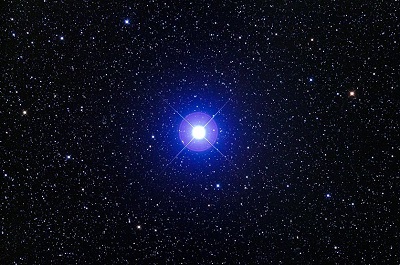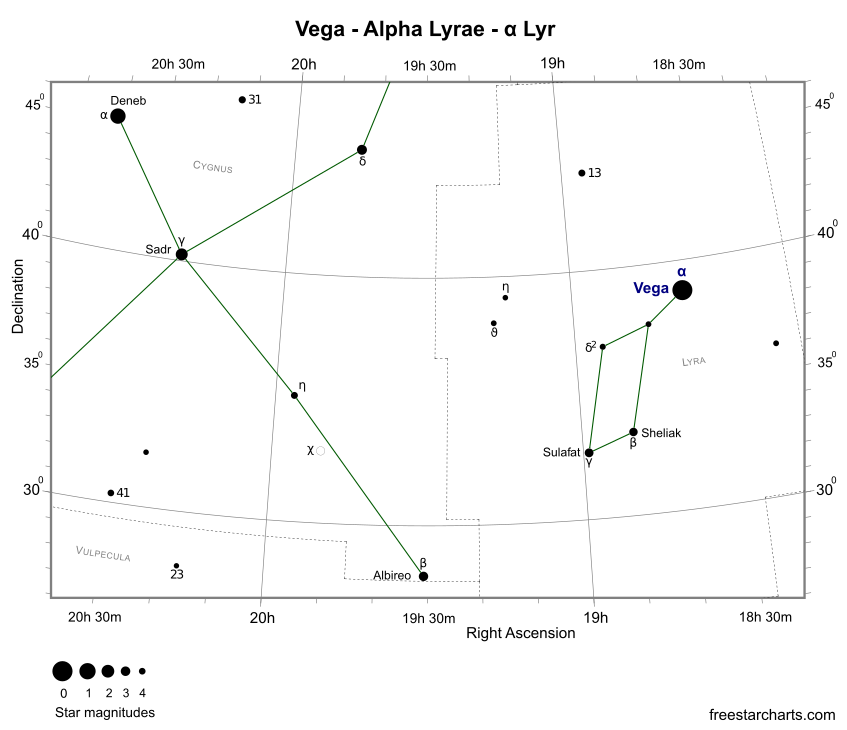Vega is a brilliant magnitude +0.03 blue-tinged white main sequence star located in the constellation of Lyra. It's marginally brighter than Capella and slightly fainter than Arcturus, making it the second brightest star in the northern section of sky. With a declination of 38 degrees north, Vega appears high in the sky and sometimes overhead from many northern temperate locations. This star can be seen anywhere north of 51 degrees south and therefore is visible from the majority of the Southern Hemisphere, including all of Australia, New Zealand, South Africa and most of Argentina and Chile.
Vega is a dazzling beacon of light in the relatively faint, but prominent constellation of Lyra. It was originally named Wega from a derivative of the Arabic phrase "Al Nasr al Waqi" or Swooping Eagle. Around 12,000 BC, Vega was the North Pole star and it will once again return there around 13,700 AD. It's probably unsurprising, given its brilliance and prominent northern declination, that Vega is one of the most investigated stars. It was one of the first stars to have its distance determined by parallax, the first star other than the Sun to be photographed and the first to have its spectrum evaluated. Vega, along with Altair (α Aqr - mag. +0.77) and Deneb (α Cyg - mag +1.25), is a member of the well-known Summer Triangle. This bright asterism was popularised, in the 1950's, by American author H.A. Rey and British astronomer Sir Patrick Moore.

Vega is a class A0Va star that's positioned within the main sequence of the Hertzsprung-Russell diagram. It's a nearby star, only 25 light-years distant, and relatively young at 455 million years. This is about 1/10 the age of the Sun. However, Vega is burning through its hydrogen fuel at a fast rate and is expected to become an M class red giant in approx. 500 million years time. For comparison, the same scenario will not affect the Sun for another 5 billion years. Even though it's more than twice as massive and over 40 times more luminous than the Sun, Vega is still not large enough to explode as a supernova and will end its life, just like our star, as a white dwarf.
Recent observations suggest that Vega is slightly variable and of the Delta Scuti type. If confirmed, it would be the brightest example of this type of star. Surrounding Vega are disks of dust and debris that extend for hundreds of astronomical units (AU). Also visible in the same field of view are two stars of magnitudes +9.5 and +11.0. Both are unrelated background stars.
The charts below show the position of Vega. It's best seen during the months of June, July and August.

Finder Chart for Vega - pdf format (credit:- freestarcharts)
Vega Data Table
| Name | Vega |
|---|---|
| Bayer | alpha (α) Lyr |
| Flamsteed | 3 Lyr |
| Constellation | Lyra |
| RA (J2000) | 18h 36m 56s |
| DEC (J2000) | +38d 47m 01s |
| Distance (light-years) | 25 |
| Apparent Mag. | +0.03 |
| Apparent Mag. Range | -0.02 -> +0.07 |
| Absolute Mag. | +0.58 |
| Spectral Type | A0Va |
| Radius (Sol) | 2.6 |
| Surface Temp. (K) | 9,600 |
| Luminosity (Sol) | 40 |
| Age (years) | 455 Million |
| Other designations | HR 7001, HD 172167, HIP 91262 |